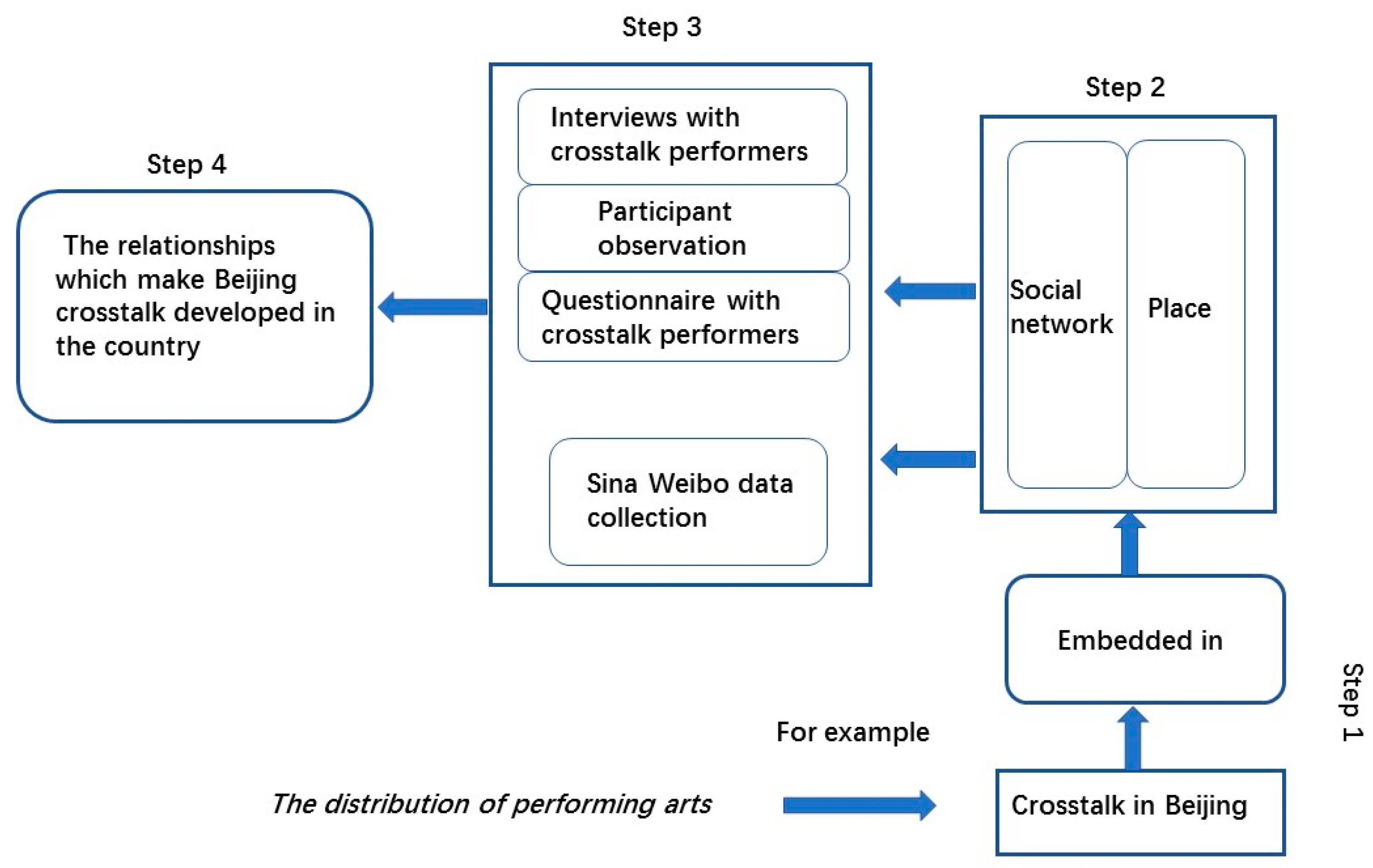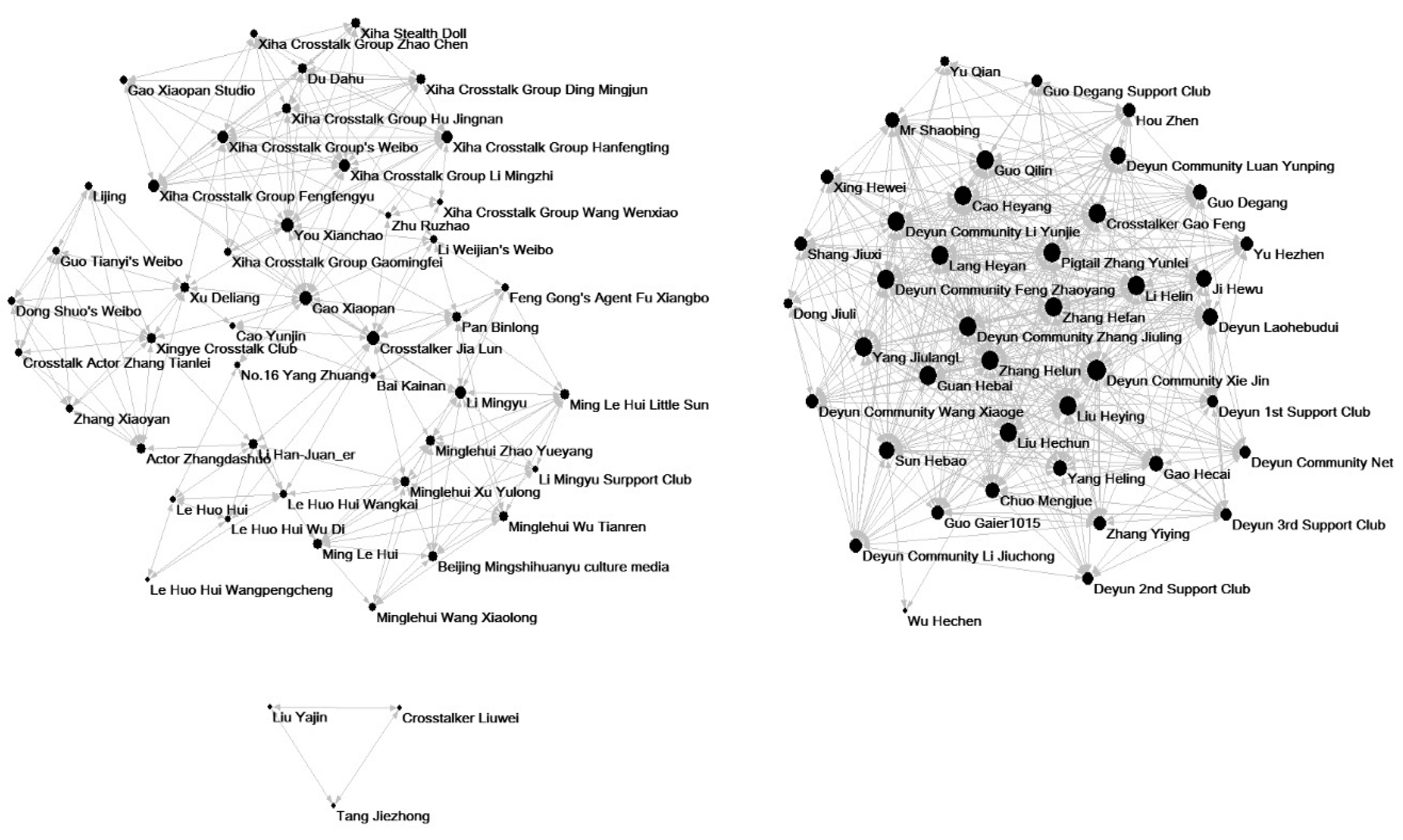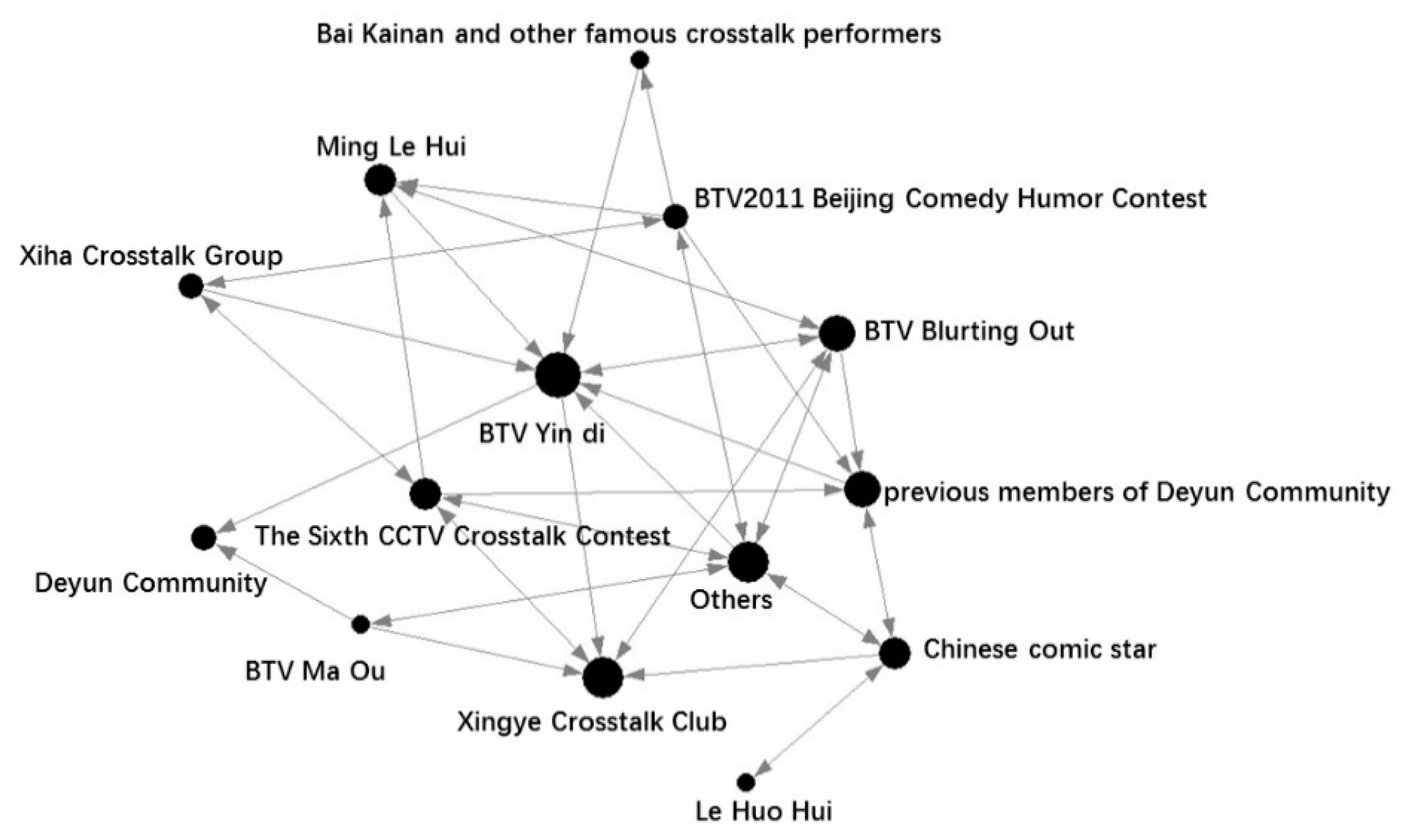Social Network and Place: The Inheritance and Development of Beijing Crosstalk Performing Art
Abstract
1. Introduction
2. Spatial Distribution of Performing Arts
2.1. Natural Geographical Environment
2.2. Language Environment
2.3. Industrial Environment
2.4. Social Environment
3. Social Network and Local Characteristics of Cultural Economy
4. Materials and Methods
4.1. Materials
4.2. Methodology
- Firstly, by reviewing the relevant literature, the factors of natural environment, language environment, industrial environment, and social environment that may affect the distribution of performing arts are analyzed. With the advancement of information, media, and transportation technologies as well as the nationwide promotion of Mandarin, the influences of the national environment and language environment on performing arts are decreasing. When beginning from the theory of embeddedness, the social network of a region and the embedded personnel, institutions, and relevant industries may be key to affecting the development of performing arts.
- Secondly, the relationship between social network theory and place theory is analyzed. Whether social network theory and place theory can be combined is discussed to explain the inheritance and development of the cultural economy of certain regions.
- Thirdly, qualitative and quantitative methods are used to collect data and analyze the social network status of practitioners of Beijing crosstalk performing art. Social networks mainly consist of two theories: self-centered network research and overall network research [50]. In this paper, we start from two aspects: one is to explore the social network relationships between individual crosstalk performers based on questionnaires and interviews; the other one is to explore the overall social network conditions of Beijing’s crosstalk industry based on mutual following data of the Sina Weibo (China’s version of Twitter) of crosstalk performers, combined with questionnaires and interviews.
5. Research on Social Network of Beijing’s Crosstalk Industry
5.1. Study of Social Networks of Beijing’s Crosstalk Performers—Based on Interviews and Questionnaire Analysis
5.1.1. Data Collection
5.1.2. Results
5.2. Research on the Social Network of Beijing’s Crosstalk Industry as a Whole—Analysis of User Data Based on Sina Weibo
5.2.1. Data Collection
5.2.2. Results
Social Connections of Heads of Crosstalk Groups—Taking Guo Degang and Gao Xiaopan as Examples
Social Connections between Crosstalk Groups
Contacts with Other Types of Performing Groups or Performers
Social Connections with the Media
6. Discussion and Conclusions
6.1. Discussion
6.2. Conclusions
7. Notes
- (1)
- In Table 2, the figures outside the brackets are the number of samples, and those in the brackets are the percentages of the samples out of all the participants (40 in this survey, i.e., 100%).
- (2)
- In Figure 3, every member in the subgroup follows two or more members and was followed by the members at the same time. Node size is proportional to the in-degree centrality.
- (3)
- Figure 4 was acquired by using simplified network technology in social network analysis according to the mutual following of Sina Weibo accounts. Node size in the figure is proportional to the in-degree centrality.
Author Contributions
Acknowledgments
Conflicts of Interest
References
- Blake, J. From Global to Local Heritage: Intangible Cultural Heritage and the Role of the Museum. Anthropol. Middle East 2015, 10, 22–40. [Google Scholar] [CrossRef]
- Keitumetse, S.O. Sustainable development and cultural heritage management in Botswana: Towards sustainable communities. Sustain. Dev. 2011, 19, 49–59. [Google Scholar] [CrossRef]
- Turgeon, L.; Divers, M. Intangible Cultural Heritage in the Rebuilding of Jacmel and Haiti Jakmèl kenbe la, se fòs peyi a! Mus. Int. 2010, 62, 106–115. [Google Scholar] [CrossRef]
- UNESCO. Convention for the Safeguarding of theIntangible Cultural Heritage 2003. Int. J. Cult. Prop. 2005, 447–458. [Google Scholar] [CrossRef]
- Bhela, A. Preserving India’s intangible cultural heritage: Issues and challenges. Int. J. Humanit. 2010, 207–214. [Google Scholar] [CrossRef]
- Zorić, S.; Kim, S.H. The Intercultural Potentials of Intangible Cultural Heritage in Korea: Existentializing Experience and Creative Economy. Narodna Umjet. Hrvat. Čas. Za Etnol. I Folkloristiku 2014, 51, 155–181. [Google Scholar] [CrossRef][Green Version]
- Liu, X.C. Industrialization of intangible cultural heritage: A controversial issue. In The Chinese Road to the Protection of Intangible Cultural Heritage; Culture and Art Publishing House: Beijing, China, 2016; pp. 144–158. ISBN 9787503960857. [Google Scholar]
- Yang, Z. Origin of crosstalk. Cross-Strait Relat. 1999, 24, 58–59. [Google Scholar]
- Qu, M.Y. A comparative study of humor culture between China and Japan. Acad. Spirit. Home Sch. 2014, 67–68. [Google Scholar] [CrossRef]
- Wang, J.; Wang, J.S.; Tengtian, X. History of Chinese Crosstalk; Beijing Yanshan Publishing House: Beijing, China, 1995; p. 57. ISBN 9787307107694. [Google Scholar]
- Hu, K.F. Why is Beijing crosstalk small theatre shrinking? Chinese Culture Newspaper 2015. [Google Scholar]
- Geng, B. The rise, current situation and development suggestions of cross talk industry in Beijing and Tianjin. In Proceedings of the Beijing, Tianjin and Hebei Regional Cooperation Forum, Tianjin, China, 5 July 2010. [Google Scholar]
- Geng, B. Investigation and Research on crosstalk performance scene in Beijing & Tianjin area. Cult. Heritage 2010, 47–55. [Google Scholar] [CrossRef]
- Hu, Z.; Arsilan, Q.D. An Overview of Chinese Cultural Geography; Peking University Press: Beijing, China, 2009; p. 89. ISBN 9787301157480. [Google Scholar]
- Glaeser, E.L. Review of Richard Florida’s The Rise of the Creative Class. Reg. Sci. Urban Econ. 2005, 35, 593–596. [Google Scholar] [CrossRef]
- Florida, R.L. The Flight of the Creative Class: The New Global Competition for Talent; HarperCollins Publishers: New York, NY, USA, 2005; ISBN 9780061993466. [Google Scholar]
- Keeble, D.; Nachum, L. Why do Business Service Firms Cluster? Small Consultancies, Clustering and Decentralization in London and Southern England. Trans. Inst. Br. Geogr. 2002, 27, 67–90. [Google Scholar] [CrossRef]
- Granovetter, M. Economic action and social structure: The problem of embeddedness. Am. J. Sociol. 1985, 91, 481–510. [Google Scholar] [CrossRef]
- Dicken, P.; Thrift, N. The Organization of Production and the Production of Organization: Why Business Enterprises Matter in the Study of Geographical Industrialization. Trans. Inst. Br. Geogr. 1992, 17, 279–291. [Google Scholar] [CrossRef]
- Kong, L. Beyond networks and relations: Towards rethinking creative cluster theory. In Kong, and O’Connor. Creative Economies, Creative Cities: Asian-European Perspectives; Springer: Berlin/Heidelberg, Germany, 2009; pp. 61–75. [Google Scholar]
- Gibson, C. Rural transformation and cultural industries: Popular music on the New South Wales Far North Coast. Aust. Geogr. Stud. 2002, 40, 336–356. [Google Scholar] [CrossRef]
- Gibson, C. Cultures at work: Why ‘culture’ matters in research on the ‘cultural’ industries. Soc. Cult. Geogr. 2003, 4, 201–215. [Google Scholar] [CrossRef]
- Einarsson, A. The Economic Impact of the Icelandic Music Industry—Structure and Management. In Proceedings of the 8th International Conference on Arts & Cultural Management, Montreal, QC, Canada, 3–6 July 2005. [Google Scholar]
- Coe, N.M. The view from out West: Embeddedness, interpersonal relations and the development of an indigenous film industry in Vancouver. Geoforum 2000, 31, 391–407. [Google Scholar] [CrossRef]
- Coe, N.M.; Johns, J. Beyond production clusters: Towards a critical political economy of networks in the film and television industries. In The Cultural Industries and the Production of Culture; Power, D., Scott, A., Eds.; Routledge: London, UK, 2004; pp. 188–204. [Google Scholar]
- Kong, L. The Sociality of cultural industries Hong Kong’s cultural policy and film Industry. Int. J. Cult. Policy 2005, 11, 61–76. [Google Scholar] [CrossRef]
- Malecki, E.J.; Veldhoen, M.E. Network Activities, Information and Competitiveness in Small Firms. Geografiska Ann. 1993, 75, 131–147. [Google Scholar] [CrossRef]
- Scott, A.J. Entrepreneurship, innovation and industrial development: Geography and the creative field revisited. Small Bus. Econ. 2006, 1–24. [Google Scholar] [CrossRef]
- Scott, A.J. The cultural economy: Geography and the creative field. Media Cult. Soc. 1999, 21, 807–817. [Google Scholar] [CrossRef]
- Pratt, A.C. New media, the new economy and new spaces. Geoforum 2000, 31, 425–436. [Google Scholar] [CrossRef]
- Borgatti, S.P.; Foster, P.C. The Network Paradigm in Organizational Research: A Review and Typology. J. Manag. 2003, 29, 991–1013. [Google Scholar] [CrossRef]
- Agnew, J. Place and Politics: The Geographical Mediation of State and Society; Allen & Unwin: Winchester, UK, 1987; p. 26. ISBN 9781317630609. [Google Scholar]
- Parkinson, M.; Meegan, R. Economic place making: Policy messages for European cities. Policy Stud. 2013, 34, 377–400. [Google Scholar] [CrossRef]
- Durmaz, S.B. Creative Clusters and Place-Making: Analyzing the Quality of Place in Soho and Beyoglu; University of Nottingham: Nottingham, UK, 2012. [Google Scholar] [CrossRef]
- Markusen, A.; Gadwa, A. Creative Placemaking; Markusen Economic Research Services and Metris Arts Consulting: Denver, CO, USA, 2010. [Google Scholar]
- Tuan, Y.F. Place: An Experiential Perspective. Geogr. Rev. 1975, 65, 151–165. [Google Scholar] [CrossRef]
- Johnson, A.; Glover, T.D.; Stewart, W.P. Attracting locals downtown: Everyday leisure as a place-making initiative. J. Park Recreat. Adm. 2014, 32, 28–42. [Google Scholar]
- Myers, F.R. Ways of Place-Making. La Ricerca Folklorica 2002, 101–119. [Google Scholar] [CrossRef]
- Heidegger, M. Poetry, Language, Thought; Harper and Row: New York, NY, USA, 1971; pp. 114–175. ISBN 9780060937287. [Google Scholar]
- Relph, E. Place and Placelessness; Pion: London, UK, 1976; p. 26. ISBN 0850860555. [Google Scholar]
- Harvey, D. From space to place and back again: Reflections on the condition of post-modernity. In Mapping the Futures: Local Cultures, Global Changes; Bird, J., Tickner, L., Eds.; Routledge: London, UK, 1993; pp. 2–29. ISBN 0203977785. [Google Scholar]
- Massey, D. For Space; Sage: London, UK, 2005; p. 141. ISBN 9781412903615. [Google Scholar]
- Massey, D. Places and Their Pasts. Hist. Workshop J. 1995, 39, 182–192. [Google Scholar] [CrossRef]
- Cresswell, T. Place: A Short Introduction; Blackwell: Oxford, UK, 2004; p. 11. ISBN 9781405106719. [Google Scholar]
- Friedman, J. Place and Place-Making in Cities: A Global Perspective. Plan. Theory Pract. 2010, 11, 149–165. [Google Scholar] [CrossRef]
- Massey, D. Space, Place, and Gender; University of Minnesota Press: Minneapolis, MN, USA, 1994; p. 141. ISBN 0816626162. [Google Scholar]
- Gao, Y.Z. The return of traditional comic dialogue and the development of cross talk art. Lit. Res. 2003, 100–105. [Google Scholar] [CrossRef]
- Yan, X.W. Weekend crosstalk Club: A hot spot for crosstalk. Beijing Daily 2004. [Google Scholar]
- Geng, B. The industrialization of crosstalk art and the reproduction of daily life. Natl. Arts 2009, 74–83. [Google Scholar] [CrossRef]
- Qi, X. Towards a Limited Community: Social Theoretical Analysis of a Residential Quarter in a City; Capital Normal University Press: Beijing, China, 2007; p. 51. ISBN 9787811190007. [Google Scholar]
- Wang, B.; Zhen, F.; Xi, G.L.; Qian, Q.; Wu, C.; Zhang, H. A study of cybergeography based on micro-blog users’ relationship: With a case of Sina micro-blog. Geogr. Res. 2013, 32, 380–391. [Google Scholar]
- Yan, W.; Huang, J.H.; Zhang, J. A review of micro-blog research: Information, services and networks. Sci. Res. Manag. 2017, 38, 123–131. [Google Scholar] [CrossRef]
- Zhang, B.; Li, Z.J. A review of information dissemination effects of micro-blog. Modern Intell. 2017, 37, 165–171. [Google Scholar]
- Feng, G. The Exporation and Practice of the Innovation of Cross Talk Art; Central China Normal University: Wuhan, China, 2001. [Google Scholar]
- Zhang, J.; Zhang, Z. Talk about cross talk. Characters 2013, 2, 180–191. [Google Scholar]
- Nicodemus, A.G. Fuzzy vibrancy: Creative placemaking as ascendant US cultural policy. Cult. Trends 2013, 22, 213–222. [Google Scholar] [CrossRef]
- Wang, J.C. Thinking on value of creative industry cluster. In Creative Industries: The New Engine of Urban Development; Li, W.W., Wang, R.Z., Eds.; Shanghai Academy of Social Sciences Press: Shanghai, China, 2005. [Google Scholar]
- Baeker, G.; Millier, L. Creative Placemaking Heritage meets the creative industries. Municipal World 2013, 2, 9–10. [Google Scholar]
- Bennett, J. Creative placemaking in community planning and development: An introduction to ArtPlace America. Community Dev. Invest. Rev. 2015, 10, 77–84. [Google Scholar]
- Vazquez, L. Creative Placemaking: Integrating Community, Cultural and Economic Development. SSRN Electron. J. 2014. [Google Scholar] [CrossRef]
- Sun, Y.Z. The Regional Characteristics of Crosstalk & Comic Sketches. Reform Open. 2010, 182. [Google Scholar] [CrossRef]
- Li, L.D. “Localization” and “presence”: Intangible Cultural Heritage in the game—A case study of the inheritance context of Tianjin cross talk. Natl. Arts 2010, 31–35. [Google Scholar] [CrossRef]




| Age | Gender | Education | Years of Learning Crosstalk | Native Place | Full-Time or Part-Time | Title |
|---|---|---|---|---|---|---|
| 35 | Male | Junior college | 28 | Beijing | Full-time | Performer |
| 26 | Male | College graduate | 3 | Shandong | Full-time | Performer |
| 26 | Male | Middle school | 1 | Beijing | Full-time | Performer |
| 14 | Male | Middle school | 3 | Beijing | Part-time | Performer |
| 28 | Male | Junior college | 3 | Liaoning | Full-time | Performer |
| 36 | Male | Junior college | 10 | Hebei | Full-time | Performer |
| 26 | Male | Junior college | 4 | Hebei | Full-time | Performer |
| 29 | Male | College graduate | 0 | Beijing | Full-time | Manager |
| The Type of Relations | The Degree of Closeness of Relationship | Way of Contact | Frequency of Contact(How Long Did you Contact Each Other) | Content of Contact(What Topic Did You Discuss) | ||||||||||
|---|---|---|---|---|---|---|---|---|---|---|---|---|---|---|
| Very Close | Not Very Close | Meet | Tele | Web | Almost Every Day | A Few Times a Week | A Few Times a Month | A Few Times a Year | Less than Once a Year | Crosstalk Professional Skills | Crosstalk Industrialization | Crosstalk Cycle Interrelationship | ||
| Teacher | 9 | 9 | 9 | 3 | 3 | 2 | 1 | 7 | 1 | 1 | ||||
| (22.5%) | (22.5%) | (22.5%) | (7.5%) | (7.5%) | (5%) | (2.5%) | (17.5%) | (2.5%) | (2.5%) | |||||
| Colleague in the present group | 15 | 14 | 1 | 11 | 4 | 8 | 4 | 2 | 1 | 8 | 6 | 1 | ||
| (37.5%) | (35%) | (2.5%) | (27.5%) | (10%) | (20%) | (10%) | (5%) | (2.5%) | (20%) | (15%) | (2.5%) | |||
| Previous colleagues, friends | 12 | 5 | 7 | 3 | 8 | 1 | 2 | 4 | 2(5%) | 3 | 1 | 8 | 1 | 3 |
| (30%) | (12.5%) | (17.5%) | (7.5%) | (20%) | (2.5%) | (5%) | (10%) | (7.5%) | (2.5%) | (20%) | (2.5%) | (7.5%) | ||
| Others | 4 | 3 | 1 | 2 | 2 | 1 | 1 | 1 | 1 | 3 | 1 | |||
| (10%) | (7.5%) | (2.5%) | (5%) | (5%) | (2.5%) | (2.5%) | (2.5%) | (2.5%) | (7.5%) | (2.5%) | ||||
| Sum | 40 | 31 | 9 | 25 | 14 | 1 | 14 | 12 | 7 | 5 | 2 | 26 | 9 | 5 |
| (100%) | (77.5%) | (22.5%) | (62.5%) | (35%) | (2.5%) | (35%) | (30%) | (17.5%) | (12.5%) | (5%) | (65%) | (22.5%) | (12.5%) | |
© 2018 by the authors. Licensee MDPI, Basel, Switzerland. This article is an open access article distributed under the terms and conditions of the Creative Commons Attribution (CC BY) license (http://creativecommons.org/licenses/by/4.0/).
Share and Cite
Zhao, J.; Zhou, S. Social Network and Place: The Inheritance and Development of Beijing Crosstalk Performing Art. Sustainability 2018, 10, 1541. https://doi.org/10.3390/su10051541
Zhao J, Zhou S. Social Network and Place: The Inheritance and Development of Beijing Crosstalk Performing Art. Sustainability. 2018; 10(5):1541. https://doi.org/10.3390/su10051541
Chicago/Turabian StyleZhao, Jimin, and Shangyi Zhou. 2018. "Social Network and Place: The Inheritance and Development of Beijing Crosstalk Performing Art" Sustainability 10, no. 5: 1541. https://doi.org/10.3390/su10051541
APA StyleZhao, J., & Zhou, S. (2018). Social Network and Place: The Inheritance and Development of Beijing Crosstalk Performing Art. Sustainability, 10(5), 1541. https://doi.org/10.3390/su10051541




